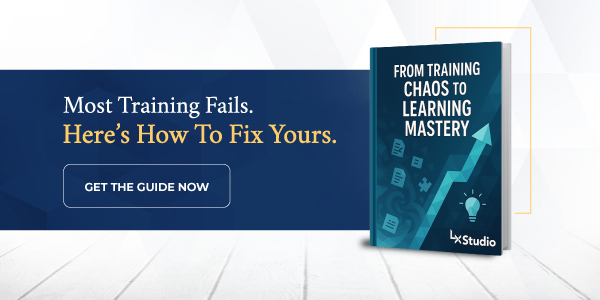
From Chaos to Clarity: Why Your Training Needs a Strategic Overhaul
It doesn't matter what type of business you're running or even the industry that you're operating in - instituting a proper training and ongoing education for your employees is a great idea for a wide range of different reasons.
According to one recent study, 92% of employees say that employee training programs (that are well-planned and executed) have a favorable impact on their overall level of engagement.
Yet at the same time, nearly 59% of employees according to a different study say that they have no workplace training at all and that most of the skills they use on a daily basis were essentially self-taught.
Not only does training help create more engaged employees, but that also has a major impact on productivity.
Not only that, it also helps avoid issues regarding long-term retention - making it easier to attract (and most importantly keep) the top talent you need to thrive.
Of course, it's equally important to note that not all strategic learning programs are created equally.
Every business will have different organizational learning objectives from the next, as well they should.
But if you try to force your training into some type of mythical "one size fits all" box, it will be worse than ineffective. In many cases, the chaos you create will only hold back your people, your business, and your future.
Thankfully, all hope is not lost.
If you find yourself in a bit of a chaotic position currently, there is a light that can shine through the darkness.
It begins with a proper training needs assessment, and also depends on your ability to keep a few things in mind along the way.
The Pitfalls of Starting with Content Instead of Strategy
There are a lot of reasons why these types of training and development programs fail - but if you had to pick one to highlight, it would undoubtedly be that they put content before strategy when building out everything that follows.
Yes, any type of training and development program will depend upon a steady stream of content that employees can understand, engage with, and derive benefit from.
But the issue is that when you start with the content instead of what the content is supposed to do for you, you're essentially getting everything backwards.
What do you need your training program to accomplish?
What do you want to be able to do at the end of it that you can't do right now?
These are the types of questions you need to answer.
When you rush to create content without first establishing some type of clear strategy, you end up making one (or even all) of the following mistakes:
- You know that you need training because you have skills gaps within your organization, but you end up investing a lot of time, money, and effort on training materials that do not address those actual gaps or other organizational challenges. You're training people on things that ultimately don't matter.
- When training content is developed in what is essentially a silo that is cut off from the rest of your organization and certainly from the people, you run the risk of creating inconsistent messaging. People who go through the training get one idea, and those who don't get another. It can confuse learners and only further complicate things.
- You're also not creating an environment where you're actually engaging with the learners. When everyone gets the same set of content and materials, it's a very passive experience.
You also quickly run into an issue where you have no idea if the training is working because it isn't addressing anything specific taking place within your enterprise.
Sure, people are completing the training - but to what end?
What benefit are you getting out of it?
This is why you need to develop a solid foundation in learning strategy before you begin - if nothing else, to avoid starting with content that can lead to misaligned training efforts.
To avoid creating irrelevant training, make sure that your strategy is in alignment with your business goals BEFORE that content is created.
Avoid the risk of fragmented learning paths by understanding the audience and what you can do to tailor content to their specific needs.
Understanding Organizational Needs: The First Step to Training Success
Speaking of organizational needs, you'll also need to conduct a thorough needs assessment to make sure you're headed in the right direction as early on in this process as possible.
Surveys and interviews are a great starting point.
You can collect qualitative and quantitative data from your employees to understand the challenges they regularly face, the skills they feel they lack, and how training can help.
Analyzing your existing performance data can also help identify certain skills gaps - including ones that you may not have even realized existed.
All this can help highlight areas that are in desperate need of continuous development.
In a larger sense, aligning training initiatives with business objectives is all about stakeholder engagement.
Again - do not try to create any type of meaningful learning materials or content in a vacuum.
Involve key stakeholders to ensure that training initiatives reflect your very real, very important organizational priorities and goals.
Map your training to those business processes and conduct regular reviews to make sure that everything is proceeding in the exact way that you need it to.
Creating Clear and Measurable Learning Objectives
As a part of your larger goal of creating clear and measurable learning objectives, one thing that you'll want to lean into is the SMART Criteria.
This involves identifying those goals and objectives that are:
- Specific. You should always define exactly what learners should know or be able to do once they go through the training.
- Measurable. You need to be able to track progress and success not just at the end of the training, but throughout it.
- Achievable. If you set realistic expectations for the training, you'll ultimately end in failure.
- Relevant. Any objectives that you set need to be aligned with your organizational goals. If they aren't, they really aren't worth the effort.
- Time-sensitive. You should set a clear schedule during which people should be able to show that they've gained something actionable from the training.
Linking objectives to organizational goals and learner needs will likely require you to map learning objectives to higher-level organizational goals to demonstrate their relevance.
You'll also want to solicit and incorporate learner feedback whenever possible so that refinements can be made.
Just because you think the training is worthwhile doesn't mean the actual learners do, after all.
An example of a well-defined learning objective across various industries might be a program taking place in the healthcare sector, for example.
If at the end of training, a significant majority of learners could administer a medication dosage calculation with a high degree of accuracy, and they couldn't when the training began, that's an example of an approach that was successful.
LX Studio's Approach: Strategy Before Content
At LX Studio, we offer custom tools for strategic planning and our Energize Strategy Canvas is one of the major examples of that.
It acts as a visual framework - a representation of your strategic priorities and training goals that make it easy for virtually anyone to follow.
This also makes it easier to collaborate with key stakeholders on the planning process, as you can be certain that everyone is on the same page and moving in the same direction.
Over the long term, this also has the added benefit of helping you focus on the KPIs and other metrics that matter most to you, guaranteeing that your training efforts are always aligned with your intended business outcomes.
Indeed, this approach is a great way to shape the entire direction that your training will take.
Our Learning Vision Canvas, for example, can help with the creation of a long-term vision for learning within your organization.
What do you do when this training session is over?
How do you take things even further with the next program?
Those are the types of questions we want to help you answer.
It also helps significantly with alignment and coherence.
As your training initiatives grow in numbers, they all need to work towards common goals.
This won't just help maximize their overall impact - it will maximize the success of your business as well.
Transforming Your Training from Messy to Masterful
In the end, it's important to remember that employee training and ongoing education is something that you do not just "for the sake of it," but because it will soon become the foundation upon which your competitive advantage is formed.
When you begin the process with a proper training needs assessment, you begin to understand the current state of your business and your employees.
You know what is working and what might not be - which gives you the type of insight you need to position training to double down on the former and get rid of the latter as much as possible.
Understanding your organizational needs is always the first step to training success.
At that point, you can create clear and measurable learning objectives, and put your strategy at the heart of your efforts.
Everything else - including the content - will then fall into place at that point.
Although the benefits of strategic training development tend to be long-term in nature, you will start to see signs that you're headed in the right direction almost immediately.
74% of workers say that they're willing to learn new skills or even re-train in order to remain employable.
About 59% of millennials claim that development opportunities like those outlined above are "extremely important" when deciding whether to apply for a position.
During a time when about 70% of organizations around the world are either experiencing a talent shortage or expect to go through one in the not-too-distant future, this alone should be worth the investment.
Well-trained and properly educated employees are happier on a day-to-day basis.
They're more engaged with their work.
That creates a better culture, which makes it easier to bring new top-tier people into the fold.
Those engaged workers tend to be more productive, which makes your business more profitable.
One benefit leads to another, then another, then another - until the organization you always hoped you'd one day be running has finally arrived.
Of course, all this depends on your ability to cut through the chaos and get to the heart of what this type of strategic development initiative is supposed to do.
That means transitioning from a content-first approach to a strategy-first one.
Thankfully, this process isn't nearly as difficult as many people assume it to be.
If you'd like to find out more information about how to go from chaos to clarity and overhaul your strategic learning in all the ways you need for success, or if you just have any additional questions that you'd like to go over with one of our team members in a bit more detail, please don't hesitate to contact LX Studio today.






